An amalgamation of everything we love about the Creta, with all that we love about EVs.
Few cars boast brand equity as strong as the Hyundai Creta. This formidable midsize SUV has long dominated its segment, thanks to its well-rounded packaging, feature-rich appeal and diverse powertrain options. Now, Hyundai has taken the winning Creta formula and electrified it, giving rise to the Creta Electric. The big question is if this battery-powered version can replicate the success of its internal combustion engine (ICE) counterpart.
The Creta Electric is built on the ICE platform, but it has undergone significant reworking to accommodate its electric powertrain. The cabin floor sits slightly higher to make room for the battery pack, the suspension has been stiffened to handle the additional weight, and the front wheels are powered by an electric motor. Despite these changes, the Creta Electric retains the dimensions of its ICE sibling, including an impressive 200mm (unladen) ground clearance.
An “electric” badge on the bootlid and pixelated accents on the bumper set this version apart from its ICE counterpart.
Hyundai Creta Electric exterior
In terms of design, the Creta Electric takes inspiration from the Creta N Line, particularly at the front. The enclosed grille, featuring a pixelated theme reminiscent of the Ioniq 5, incorporates a centrally placed charging port. This pixelated motif extends to the closed front air dam, which includes active flaps to enhance aerodynamic efficiency. The 17-inch aero-style alloy wheels further emphasise its EV identity, and they come wrapped in lowrolling resistance, EV-specific tyres.
Adding to its aesthetic appeal are silver highlights on the lower edges of the black plastic cladding, creating a striking contrast. Our dual-tone test unit featured black pillars, a black roof, and a black rear spoiler for added flair. Unique identifiers, such as an “electric” badge on the bootlid and pixelated accents on the rear bumper, set this version apart from its ICE counterpart.
The sight of its battery pack beneath its body looks a bit ungainly, especially when viewed from the sides.

Flaps on the front air dam automatically open and close to improve aerodynamic efficiency.
Hyundai Creta Electric interior
Step into the Creta Electric’s cabin, and you’ll immediately notice its resemblance to the ICE version. However, several EV-specific upgrades make it distinct. A notable addition is the all-new three-spoke steering wheel with a circular horn boss, adorned with four dots symbolising the letter ‘H’ in Morse code. Interestingly, the steering buttons have been rearranged – the infotainment and phone controls are now on the right, while ADAS functions are on the left.
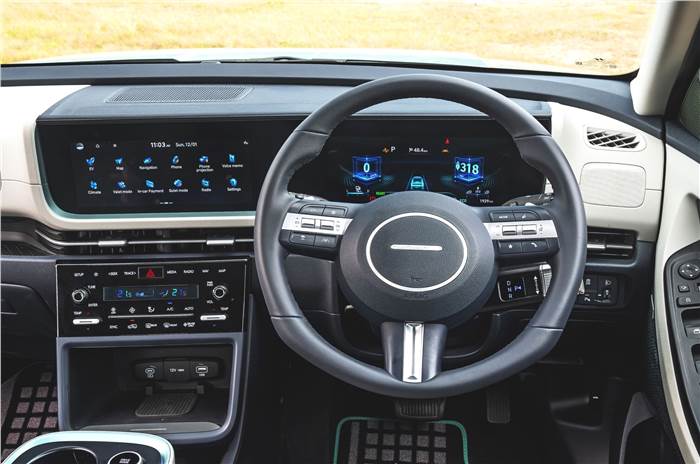
New three-spoke steering wheel with a circular horn boss; four dots symbolise the letter ‘H’ in Morse code.
The familiar 10.25-inch instrument cluster now features an additional cube-like theme, akin to the Ioniq 5. The air conditioning console – borrowed from the updated Alcazar – combines infotainment shortcuts with touch-sensitive keys, although practical physical toggles for temperature and a volume knob remain.
A standout addition is the steering column-mounted drive selector, reminiscent of the Ioniq 5. This design frees up the centre console, which now adopts a floating style. It houses a drive mode button, an electric parking brake, an auto-hold button, ventilated front seat controls, and dual cupholders. Impressively, there’s a lower deck area beneath it which houses a fair bit of storage space. Even the armrest console is huge, and like the glovebox, it features a cooling vent to keep beverages cool.
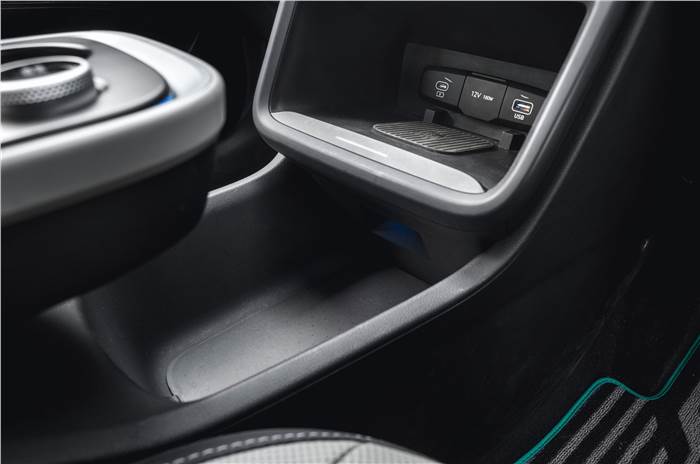
Lower deck area beneath the centre console houses a fair bit of storage space.
In line with Hyundai’s sustainable focus, the seats are upholstered in eco-friendly materials derived from corn extracts and recycled plastic bottles. Surprisingly, the texture is smooth and closely resembles the leatherette used in the ICE model.
The slightly higher floor impacts the driving position, which feels elevated even at its lowest setting. While rear seat space remains unchanged and is comfortable, the seating postureis slightly knees-up. A new boss-function allows rear passengers to electronically slide the front passenger seat forward, enhancing legroom. Utility trays on the front seatbacks include grooves for mobile devices and integrated pop-open cupholders for added convenience.

You’re seated in a slightly knees-up position, although it isn’t uncomfortable.
Additionally, the Creta Electric features a V2L (Vehicle-to-Load) system with a 3-pin power socket, enabling users to power devices like laptops or small appliances.
Storage capacity remains practical with the unchanged 433-litre boot, complete with a spare tire under the boot floor. A 22-litre frunk provides extra loading space beneath the bonnet.
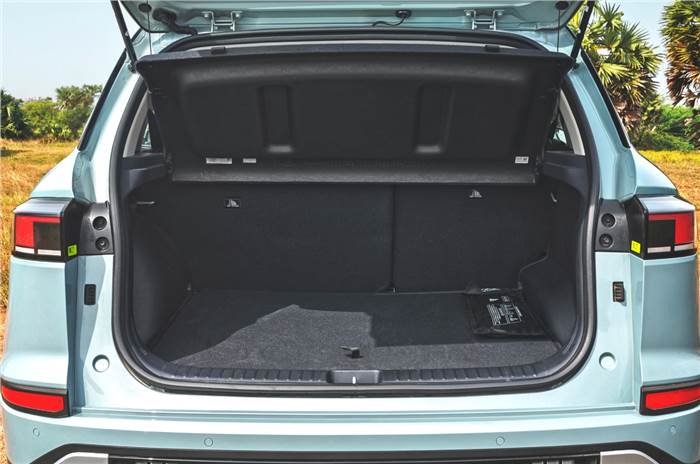
433-litre boot remains just as practical as the ICE version; gets a spare tyre beneath the floor, too.
Hyundai Creta Electric features
Besides carrying forward the ICE version’s feature-set, the Electric gets some new equipment too, like rain-sensing wipers, electric front seats with driver’s seat memory, a cooling central console, boss seat function as well as front seatback-mounted utility trays. It carries forward the Autonomous Driver Assistance Systems (ADAS) suite, which, like in the standard Creta, adds a safety net without feeling too intrusive in its function.
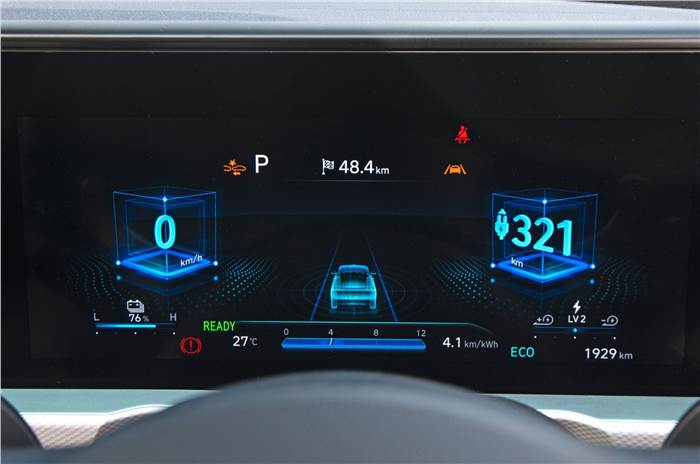
Familiar 10.25-inch instrument cluster gets new cube-like display theme.
Hyundai has invested heavily in developing an in-car payments option, which, with a mere touch, facilitates a wallet-based payment for vehicle charging, as well as future subscription-based features. In addition, the company has developed a first-of-its-kind mobile application through which users can not only identify and navigate to over 10,000 EV chargers across different brands but also make payments via the app to certain service providers. This eliminates the hassle of downloading and registering on multiple brand-specific applications.
We’re still sore that like the standard Creta, it misses out on things like wireless Android Auto and Apple CarPlay, adjustable front armrest, a headrest for the middle rear passenger, and the volume of its 8-speaker Bose setup is much lower at the rear than in the front. Also, compared to the large screens of its competitors, the Creta Electric’s 10.25-inch touchscreen comes across as a bit small.
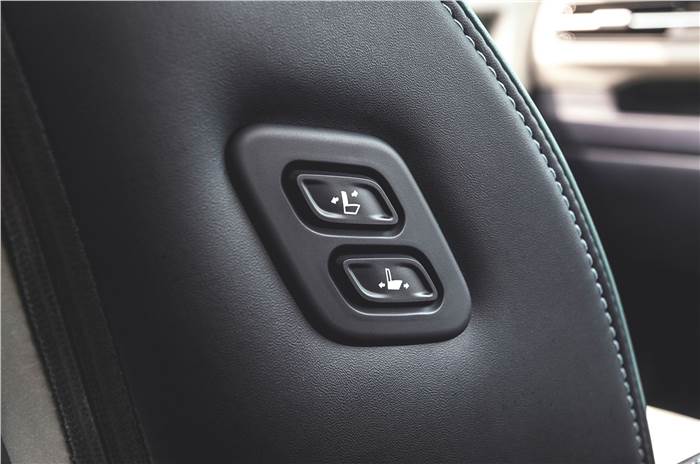
A new boss-function allows rear passengers to electronically slide the front passenger seat forward, enhancing legroom.
Hyundai Creta Electric performance
The Creta Electric is offered with two battery options: a 42kWh pack and a 51.4kWh Long Range pack. Both utilise Nickel Manganese Cobalt (NMC) cell chemistry, similar to the Ioniq 5. This type of battery is more compact and energy-dense than Lithium Ferrous Phosphate (LFP) batteries, although LFP batteries are known for their longer lifespan. For added peace of mind, Hyundai offers an 8-year/1,60,000km warranty on the battery, alongside the standard 3-year warranty on the car.
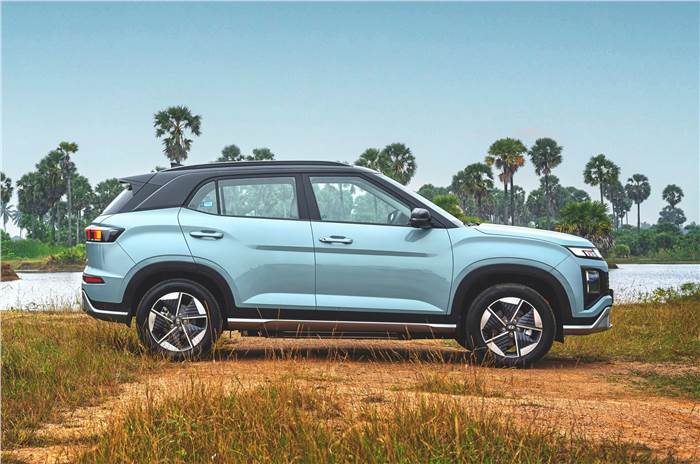
The sight of its battery pack from the side looks a bit ungainly.
Powering the Creta Electric is a single motor on the front axle that drives the front wheels. In the Long Range variant, this motor produces 171hp and 255Nm. Interestingly, its torque matches the diesel variant’s 250Nm and is close to the turbo-petrol’s 260Nm. However, being an EV, the power delivery is strong yet exceptionally linear. Acceleration feels brisk and effortless, even in its most efficient ‘Eco’ mode. The three drive modes – Eco, Normal and Sports – deliver noticeably different responses to part-throttle inputs, while flooring the accelerator unleashes the motor’s full potential. A synthesised bassy hum under hard acceleration adds a touch of drama to the otherwise silent drive.
In our tests, the Creta Electric managed a 0-100kph time of 8.2 seconds, slightly behind the claimed 7.9 seconds. Flat out, it can achieve a top speed of 180kph.

Acceleration feels brisk and effortless, but real-world range of over 400km impresses.
The Creta gets a total of five regenerative braking options, with Level 1, 2 and 3 adjusting deceleration and bringing the car to a crawl.While these modes are mild, Levels 4 and 5 are strong. Drivers can also disable regenerative braking entirely for a free-rolling experience or opt for the ‘i-Pedal’ mode, which allows one-pedal driving by bringing the car to a complete stop without using the brake pedal. Each mode feels distinct and natural, making them intuitive to use. Adaptive cruise control integrates seamlessly with the regen system, adjusting braking automatically based on the situation, though drivers can override this using steering-mounted paddle shifters.
Hyundai Creta Electric range and charging
The 42kWh battery variant has an ARAI-certified range of 390km, while the 51.4kWh Long Range version offers 473km. In a mixed driving cycle of city and highway conditions, our preliminary test of the Long Range variant returned an impressive real-world range of approximately 426km. For reference, our 289.6km drive at an average speed of 41kph toggling through different drive and regenerative braking settings, utilised 68 percent of the charge.
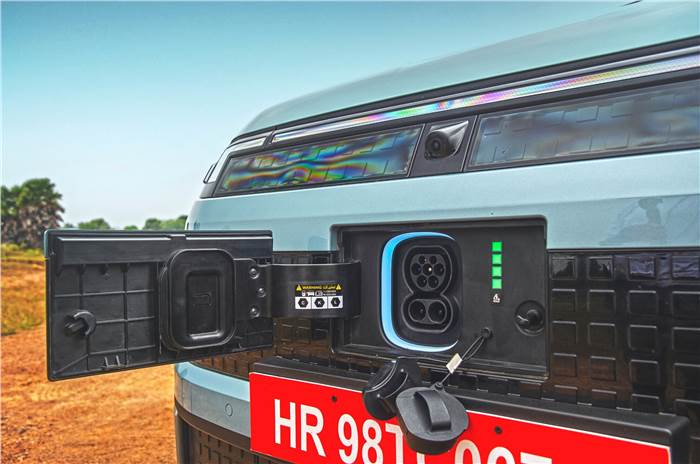
Charging port behind the enclosed front grille gets an LED indicator.
Hyundai claims the battery can be charged from 10 to 80 percent in just 58 minutes using a 50kW DC fast charger. With a 11kW AC charger, the larger battery charges fully (10 to 100 percent) in 4 hours and 50 minutes, while the smaller battery completes this in 4 hours.
Hyundai Creta Electric ride and handling
To support the additional weight of the battery and motor, the Creta Electric’s suspension is stiffer than the ICE version’s. Remarkably, it doesn’t translate into a crashy or uncomfortable ride experience. Yes, you can feel its firmness at low speeds, and you’ll also hear its suspension ‘thwack’ over sharp bumps (particularly due to an otherwise silent cabin), but road shocks are still well in check. What’s nice is that the stiffness has eliminated unnecessary (secondary) body movements, and even at highway speeds, the Creta Electric doesn’t lose its poise.
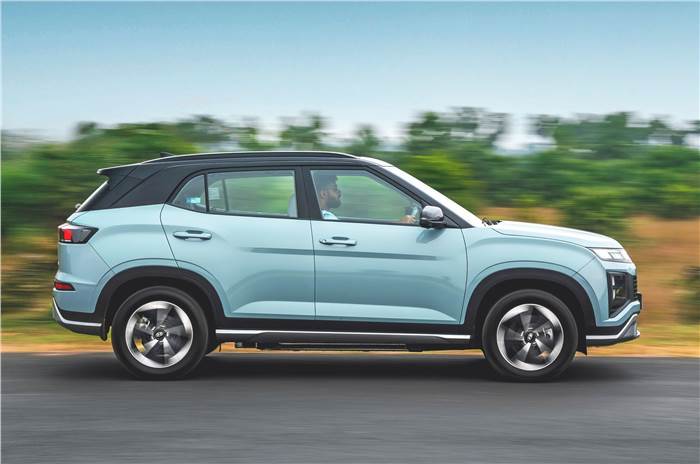
The steering, too, is noticeably heavier than the ICE version’s, and as a result, it warrants more effort at slow and parking speeds. But at no point does it feel excessive or cumbersome. And while it hasn’t resulted in more feel or feedback per se, the added weight only adds to the driver’s confidence, especially at high speeds or around a series of bends. Also nice is that the Creta Electric changes directions well, and with its weight being concentrated lower down, body roll seems to be far better controlled than the petrol-version. Notably, the Electric’s braking is so good, the transition from regenerative to frictional brakes feels extremely smooth and superbly calibrated, thus lending to a very natural brake pedal feel.
Hyundai Creta Electric verdict
The Creta Electric has its flaws – the ride is stiffer than the ICE version’s; the steering is a bit weighty; and finally, its floor is a bit raised, which results in a slightly knees-up position. But none of these are a dealbreaker.
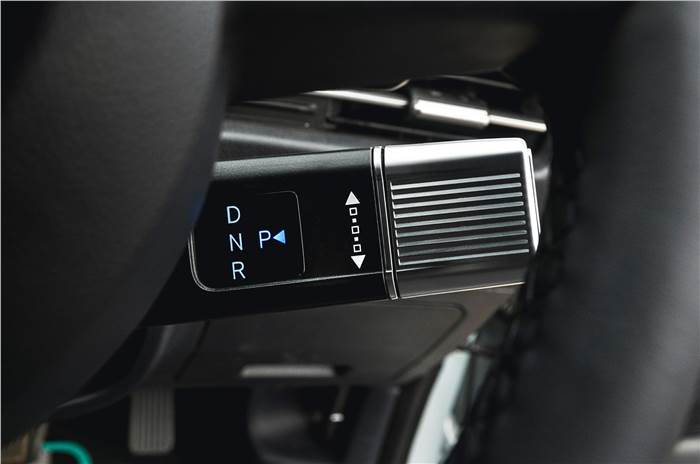
A standout addition is the steering column-mounted drive selector, akin to the Ioniq 5.
The Electric version still retains the ICE’s brilliant packaging like its spacious cabin, ample practicality, and a decently sized boot – it gets a frontal loading area (frunk), too. Performance is smooth, linear and reasonably quick. But what’s even more impressive is its real-world range of over 400km, with reasonable charging times. And even though its suspension is firmer than the ICE Creta’s, it gets a newfound confidence in the ride and handling department. Typical to the Creta’s proposition, this electric iteration is feature-rich, too. At a price ranging between Rs 18 lakh and Rs 23.50 lakh, the Creta Electric comes across as a fantastic EV. Will it replicate the ICE’s success? If first impressions are anything to go by, the Creta Electric seems to have what it takes to dominate the EV space.
Also see:
Hyundai Creta Electric to be followed by 3 made-in-India EVs
Hyundai Creta Electric, Ioniq 9, Staria to be showcased at Auto Expo 2025
Hyundai Venue, Verna, Grand i10 Nios line-ups updated for 2025





